MICROSCOPE-ANTIQUES.COM © 2013-15.
PORTABLE COMPOUND STUDENT MICROSCOPE:
c. 1919-24
MODEL: 'IMPROVED NATURE MICROSCOPE'
SIGNED: 'C.BAKER, LONDON' inside a lens emblem, with the first two numbers of the serial number on the left of the emblem, and the other three to the right, when facing the signature.
Serial Number:17436
DESCRIPTION
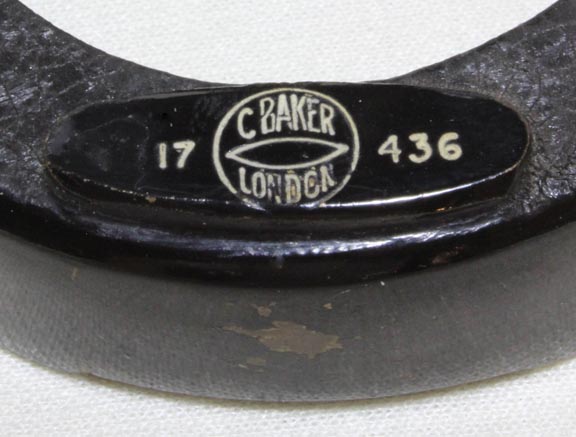
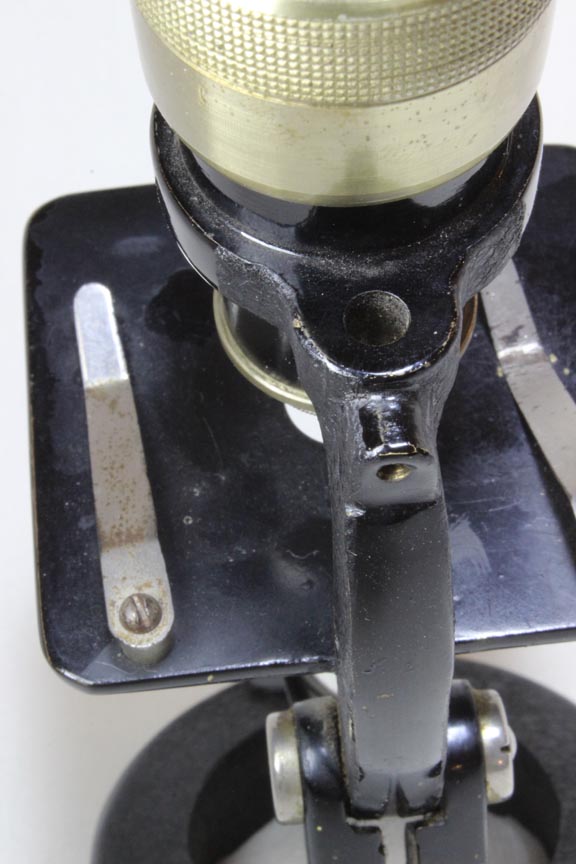 This is a well made small compound microscope. It arises from a heavy solid-iron foot in the shape of a split ring. At the rear of the ring, where each half of the ring ends, the metal turns upward to form trunnions between which the limb is suspended. The Lister limb is one solid piece from the arm to the end of the tail piece, including the stage. The limb has a range of inclination that can be varied from vertical to 45 degrees. There is a gimbaled concave mirror which can be removed from the tailpiece and attached to the hole in the side of the limb for top lighting an opaque subject. Two chrome-plated stage clips are attached to the stage by screws. Focus, which is relatively fine, is by turning the main tube via a knurled brass outer casing. There is a divisible objective. There are two calibrated aluminum(?) draw tubes to vary magnification which are each engraved with numbers from 40 to 100 with markings at each number and halfway between each number. In addition to the hole on the side of the limb for the mirror, there is a small horizontal hole at the top of the limb and a larger vertical hole in the arm. The foot of this instrument is about 2 5/8 inches (65 mm)diameter. The stage measures 2 inches (5cm) deep and about 2 1/2 inches (55mm) wide. The scope is about 6 inches high at a minimum and about 10 inches high in the vertical position with both tubes extended. According to the Baker catalogs, the magnification can be varied between 25 and 200 times. The finish of this instrument is gloss black on the outer vertical surface of the foot, the top of the stage and the optical tube except for the brass. There is a crinkle black finish on the top surface of the ring of the foot, as well as its inside surface, with the exception of the signature/serial area which is gloss black with white lettering of the engraving.
This is a well made small compound microscope. It arises from a heavy solid-iron foot in the shape of a split ring. At the rear of the ring, where each half of the ring ends, the metal turns upward to form trunnions between which the limb is suspended. The Lister limb is one solid piece from the arm to the end of the tail piece, including the stage. The limb has a range of inclination that can be varied from vertical to 45 degrees. There is a gimbaled concave mirror which can be removed from the tailpiece and attached to the hole in the side of the limb for top lighting an opaque subject. Two chrome-plated stage clips are attached to the stage by screws. Focus, which is relatively fine, is by turning the main tube via a knurled brass outer casing. There is a divisible objective. There are two calibrated aluminum(?) draw tubes to vary magnification which are each engraved with numbers from 40 to 100 with markings at each number and halfway between each number. In addition to the hole on the side of the limb for the mirror, there is a small horizontal hole at the top of the limb and a larger vertical hole in the arm. The foot of this instrument is about 2 5/8 inches (65 mm)diameter. The stage measures 2 inches (5cm) deep and about 2 1/2 inches (55mm) wide. The scope is about 6 inches high at a minimum and about 10 inches high in the vertical position with both tubes extended. According to the Baker catalogs, the magnification can be varied between 25 and 200 times. The finish of this instrument is gloss black on the outer vertical surface of the foot, the top of the stage and the optical tube except for the brass. There is a crinkle black finish on the top surface of the ring of the foot, as well as its inside surface, with the exception of the signature/serial area which is gloss black with white lettering of the engraving.
HISTORY OF THE BAKER NATURE MICROSCOPES
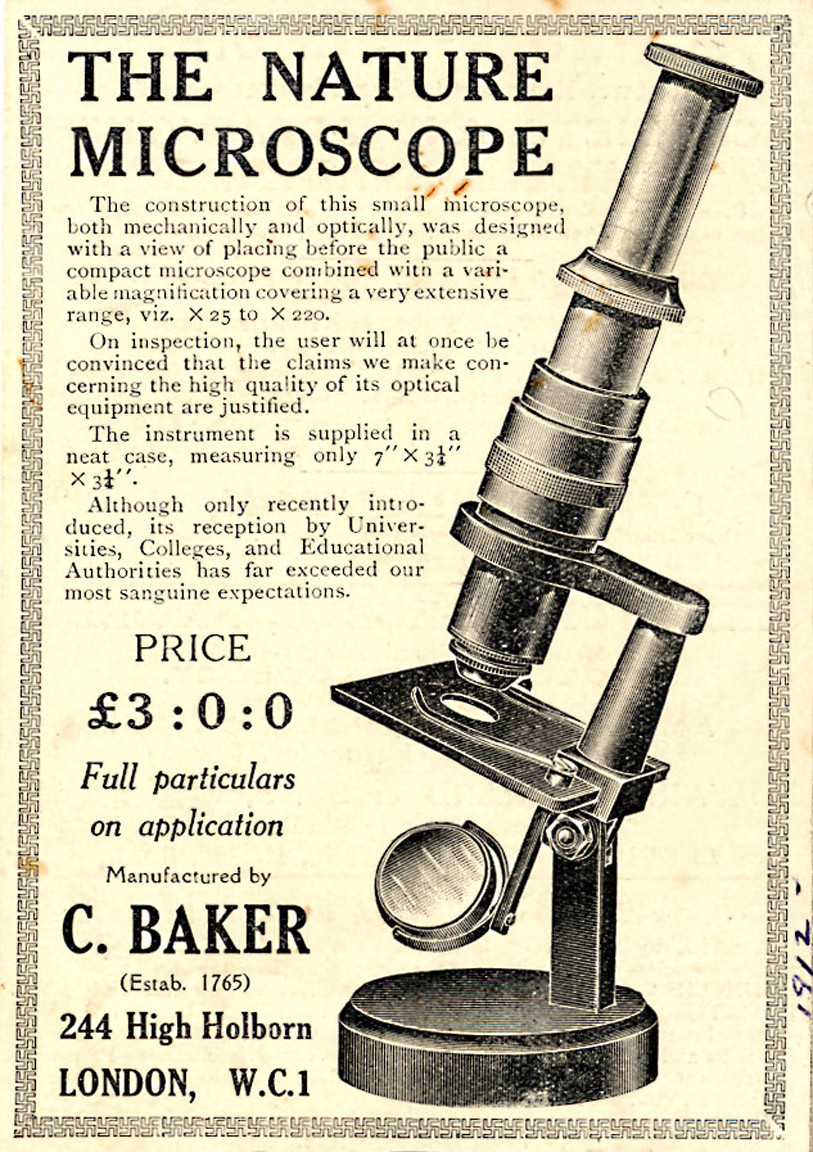
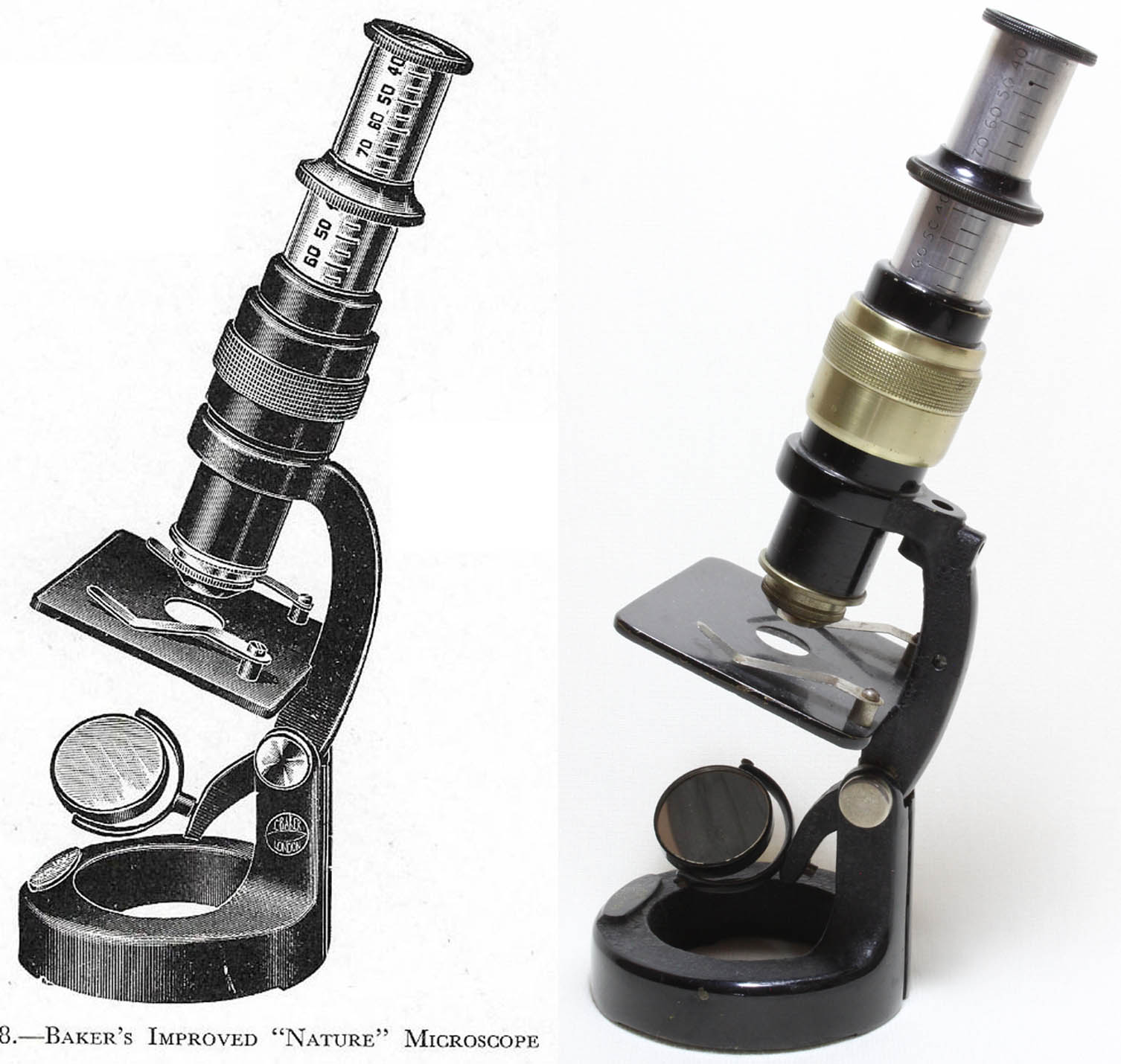 Charles Baker's firm made microscopes for over 100 years starting about 1851. They produced many good stands of their own make, perhaps most uniquely, the Nelson-Curties Model, but eventually were also agents for many of the well known makers, foreign and domestic. The Nature microscope was first offered in advertisements(left) and in the Baker catalogs from about 1912. The 'improved' version was first offered around 1919. It apparently did not appear in the catalogs after 1924. Note that the example shown on this web page differs from the engraving(right) slightly at the top of the limb.
Charles Baker's firm made microscopes for over 100 years starting about 1851. They produced many good stands of their own make, perhaps most uniquely, the Nelson-Curties Model, but eventually were also agents for many of the well known makers, foreign and domestic. The Nature microscope was first offered in advertisements(left) and in the Baker catalogs from about 1912. The 'improved' version was first offered around 1919. It apparently did not appear in the catalogs after 1924. Note that the example shown on this web page differs from the engraving(right) slightly at the top of the limb.
For a discussion of the 19th and early 20th century microscopes made by the Charles Baker company, please see the following article:
Solliday, James D. : Charles Baker: His Contributions to Microscopy. Quekett J. Microscopy: vol 37, pp633-646, 1996.
The author is grateful to James Solliday for details pertaining to the years of production of the Nature and Improved Nature Microscopes.
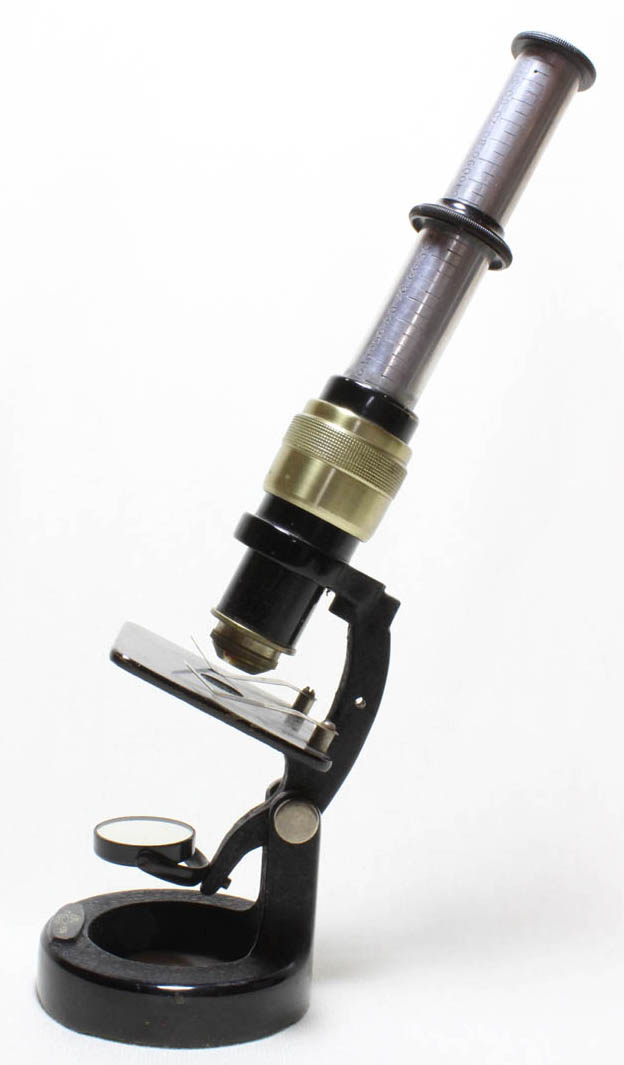
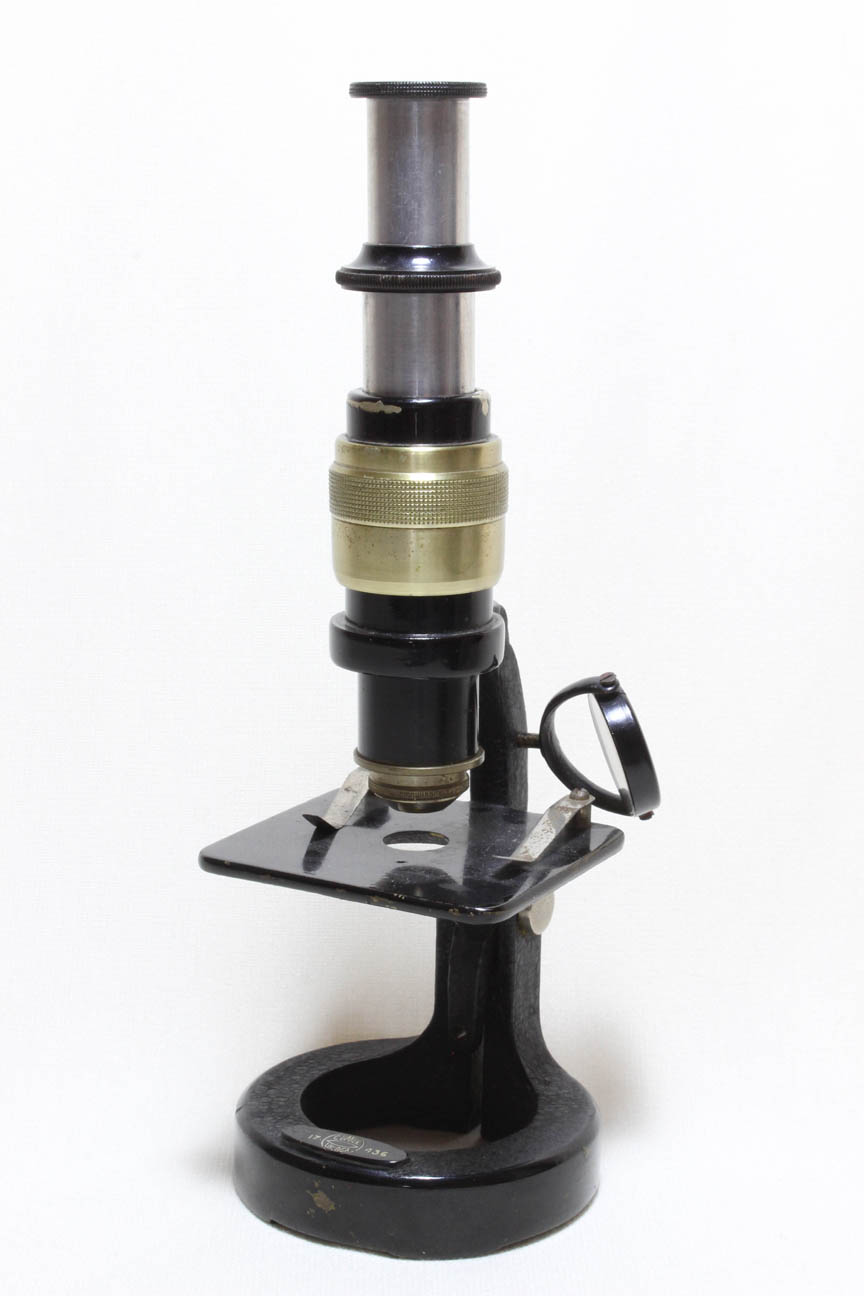
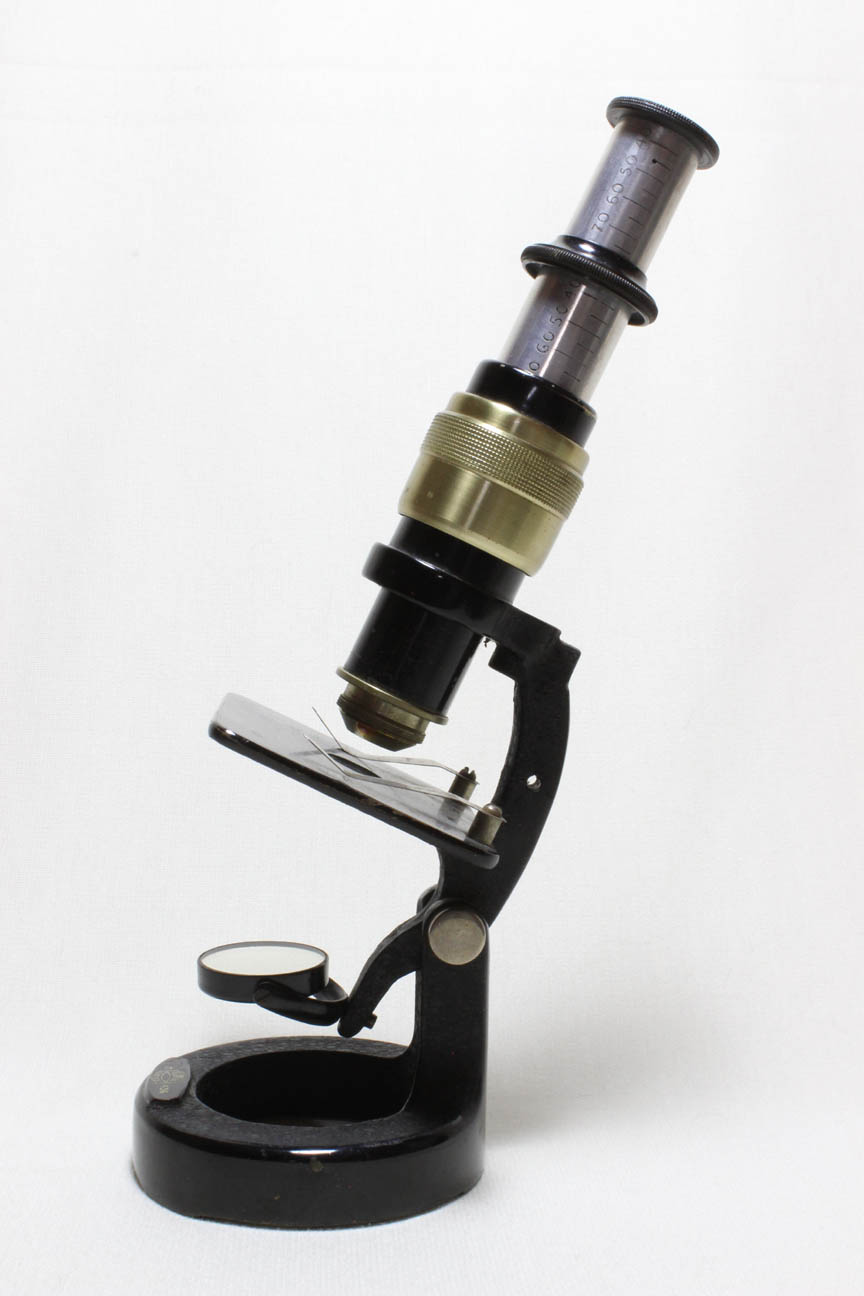
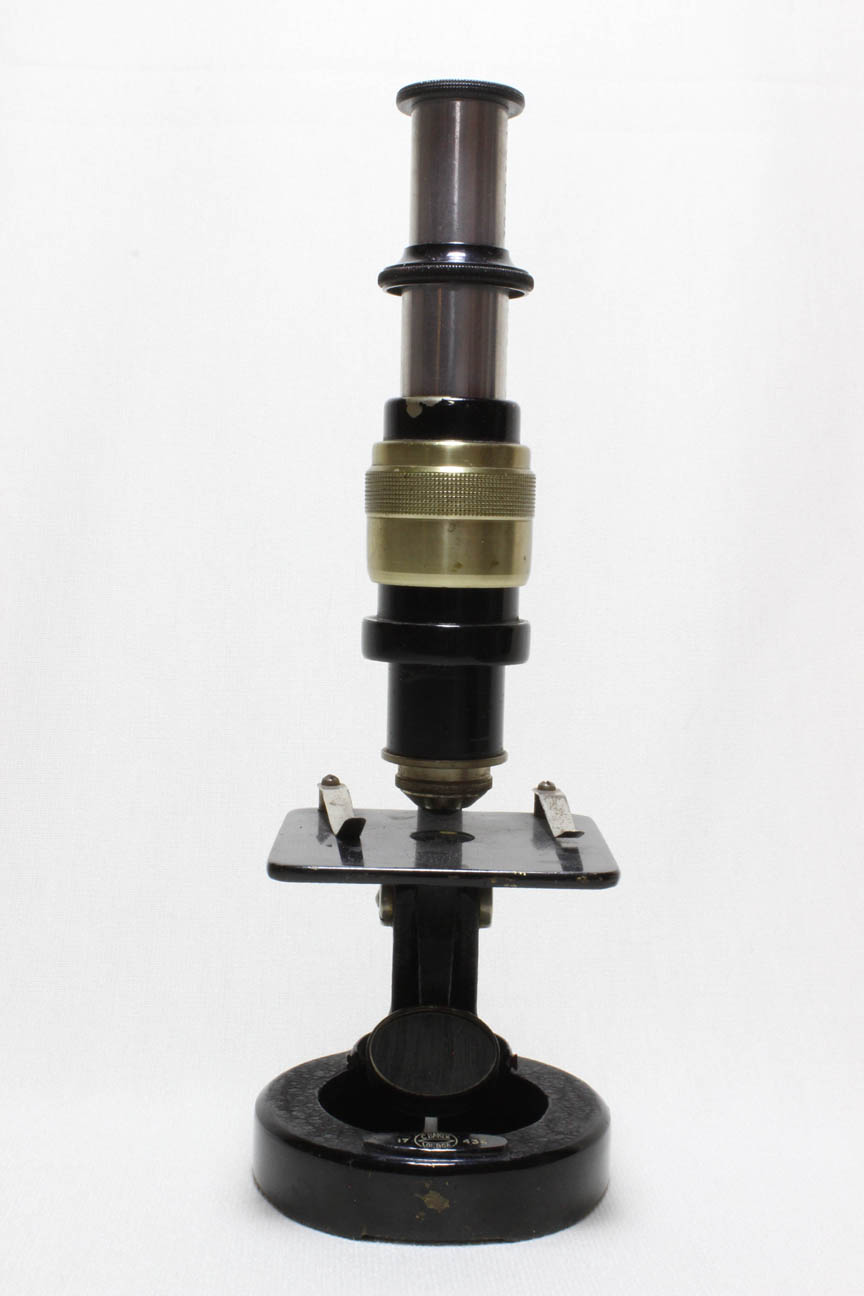
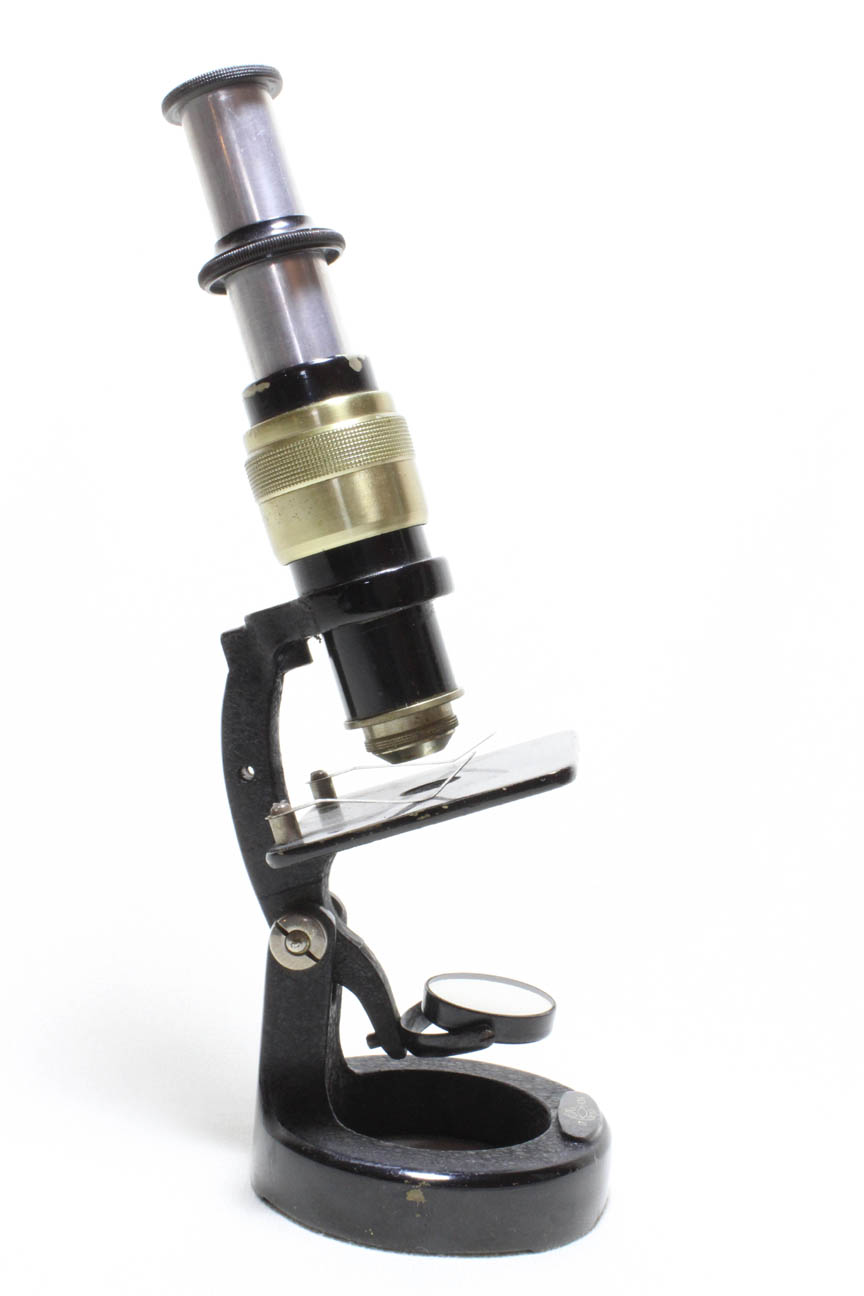
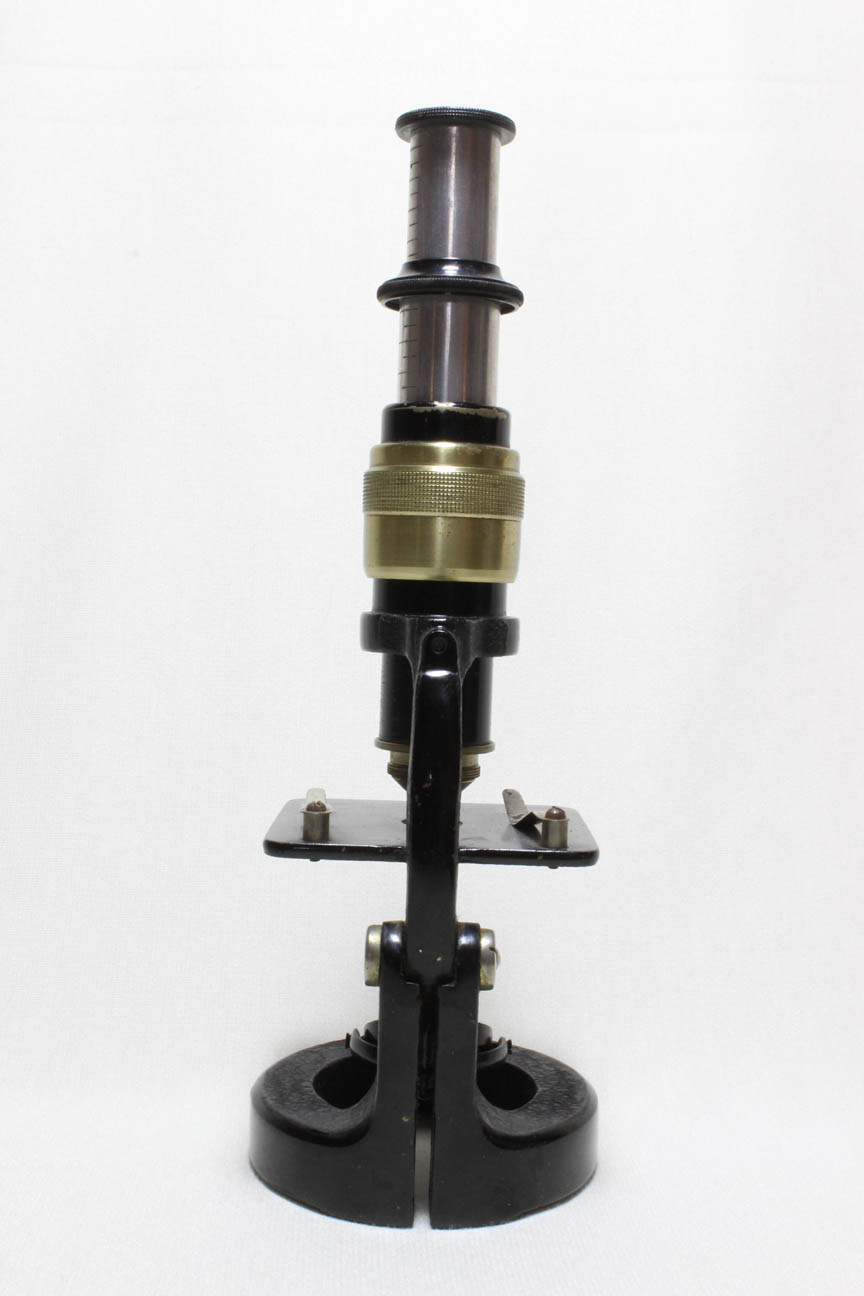

 This is a well made small compound microscope. It arises from a heavy solid-iron foot in the shape of a split ring. At the rear of the ring, where each half of the ring ends, the metal turns upward to form trunnions between which the limb is suspended. The Lister limb is one solid piece from the arm to the end of the tail piece, including the stage. The limb has a range of inclination that can be varied from vertical to 45 degrees. There is a gimbaled concave mirror which can be removed from the tailpiece and attached to the hole in the side of the limb for top lighting an opaque subject. Two chrome-plated stage clips are attached to the stage by screws. Focus, which is relatively fine, is by turning the main tube via a knurled brass outer casing. There is a divisible objective. There are two calibrated aluminum(?) draw tubes to vary magnification which are each engraved with numbers from 40 to 100 with markings at each number and halfway between each number. In addition to the hole on the side of the limb for the mirror, there is a small horizontal hole at the top of the limb and a larger vertical hole in the arm. The foot of this instrument is about 2 5/8 inches (65 mm)diameter. The stage measures 2 inches (5cm) deep and about 2 1/2 inches (55mm) wide. The scope is about 6 inches high at a minimum and about 10 inches high in the vertical position with both tubes extended. According to the Baker catalogs, the magnification can be varied between 25 and 200 times. The finish of this instrument is gloss black on the outer vertical surface of the foot, the top of the stage and the optical tube except for the brass. There is a crinkle black finish on the top surface of the ring of the foot, as well as its inside surface, with the exception of the signature/serial area which is gloss black with white lettering of the engraving.
This is a well made small compound microscope. It arises from a heavy solid-iron foot in the shape of a split ring. At the rear of the ring, where each half of the ring ends, the metal turns upward to form trunnions between which the limb is suspended. The Lister limb is one solid piece from the arm to the end of the tail piece, including the stage. The limb has a range of inclination that can be varied from vertical to 45 degrees. There is a gimbaled concave mirror which can be removed from the tailpiece and attached to the hole in the side of the limb for top lighting an opaque subject. Two chrome-plated stage clips are attached to the stage by screws. Focus, which is relatively fine, is by turning the main tube via a knurled brass outer casing. There is a divisible objective. There are two calibrated aluminum(?) draw tubes to vary magnification which are each engraved with numbers from 40 to 100 with markings at each number and halfway between each number. In addition to the hole on the side of the limb for the mirror, there is a small horizontal hole at the top of the limb and a larger vertical hole in the arm. The foot of this instrument is about 2 5/8 inches (65 mm)diameter. The stage measures 2 inches (5cm) deep and about 2 1/2 inches (55mm) wide. The scope is about 6 inches high at a minimum and about 10 inches high in the vertical position with both tubes extended. According to the Baker catalogs, the magnification can be varied between 25 and 200 times. The finish of this instrument is gloss black on the outer vertical surface of the foot, the top of the stage and the optical tube except for the brass. There is a crinkle black finish on the top surface of the ring of the foot, as well as its inside surface, with the exception of the signature/serial area which is gloss black with white lettering of the engraving.

 Charles Baker's firm made microscopes for over 100 years starting about 1851. They produced many good stands of their own make, perhaps most uniquely, the Nelson-Curties Model, but eventually were also agents for many of the well known makers, foreign and domestic. The Nature microscope was first offered in advertisements(left) and in the Baker catalogs from about 1912. The 'improved' version was first offered around 1919. It apparently did not appear in the catalogs after 1924. Note that the example shown on this web page differs from the engraving(right) slightly at the top of the limb.
Charles Baker's firm made microscopes for over 100 years starting about 1851. They produced many good stands of their own make, perhaps most uniquely, the Nelson-Curties Model, but eventually were also agents for many of the well known makers, foreign and domestic. The Nature microscope was first offered in advertisements(left) and in the Baker catalogs from about 1912. The 'improved' version was first offered around 1919. It apparently did not appear in the catalogs after 1924. Note that the example shown on this web page differs from the engraving(right) slightly at the top of the limb.